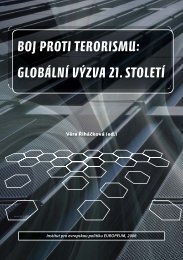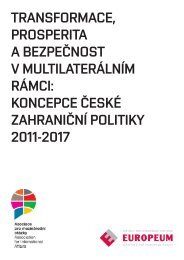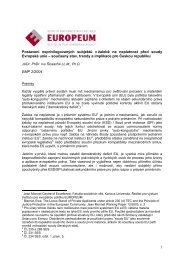eu constitutionalisation - EUROPEUM Institute for European Policy
eu constitutionalisation - EUROPEUM Institute for European Policy
eu constitutionalisation - EUROPEUM Institute for European Policy
You also want an ePaper? Increase the reach of your titles
YUMPU automatically turns print PDFs into web optimized ePapers that Google loves.
Chapter 1: Constitutionalisation: the Case of the Convention as a Network AnalysisJan Kohout as the government representative adhered to his socialist loyalties,but he was also involved in the group of like-minded states. Themain tenets of their common statement had already been expressed inCzech government’s non-paper⁷². The government supported a “mixedmodel” based on preserving balance between intergovernmental andsupranational/ federal models. This method can lead to the “derivedfederation” model, which exists e.g. in Canada. Thus an “ever closerUnion” would respect nation states and their positions in key areas ofnational sovereignty, at the time it would strengthen cooperation inall fields.⁷³Josef Zieleniec was mainly involved in the activities of the Christian democraticEPP group. He supported a transfer of competencies to the federallevel. His model of federal state corresponded to the idea of a decentralizedasymmetrical unitary state. Zieleniec supported further politicisation of thedecision-making processes in the EU; the President of the Commissionwould be elected by the <strong>European</strong> parliament according to the result of EPelections. Zieleniec’s motto was: “if we give <strong>European</strong>s <strong>European</strong> politics,they will give Europe their hearts and trust”.⁷⁴Jan Zahradil associated himself with a group of <strong>European</strong> Democrats led bya Danish Eurosceptic Jens-Peter Bonde. His model is close to pure confederation,in which every step requires confirmation by national institutions.Zahradil supported the economic integration of the EU, but he rejects itspolitical dimension. On 12 June, the day be<strong>for</strong>e the final text of Part I ofthe constitution treaty was accepted, Zahradil left the Convention. The followingday he called a press conference in Prague, in which he reproachedValéry Giscard d’Estaing <strong>for</strong> manipulating the process. This was the daywhen the Czech accession referendum was held, and a rare moment whenCzech public was thinking “<strong>European</strong>”. Zahradil’s proclamation did notfail to catch attention⁷⁵, however it did not overshadow the referendumitself; 55, 21 per cent of voters took part, and 77, 33 per cent of them votedin favour of membership.⁷⁶72) <strong>European</strong> Convention, Non paper on the re<strong>for</strong>m of EU institutions73) The author as an Alternate member of the Convention was using internal materials of the government.74) Speech to the Convention by Senator Josef Zieleniec, 21 March 200275) 78 Lidové noviny, 12 June 2003, Zahradil opustil Konvent76) Lidové noviny, 16 June 2003, p. 1544Chapter 1: Constitutionalisation: the Case of the Convention as a Network AnalysisCONCLUSIONThis chapter tried to explain the Convention as an innovation in EU <strong>constitutionalisation</strong>process, and highlighted the need to determine applicabletheories. It is argued that theories of <strong>European</strong> integration can be applied tothe <strong>European</strong> Convention, which can be perceived as a kind of microcosmof the integration process. The two grand theories of <strong>European</strong> integration,neofunctionalism and intergovernmentalism, are legitimate but canonly offer limited options, such as in understanding the ‘red lines’ in theBritish approach. The chapter suggests that <strong>for</strong> a multifaceted, complex andmany actors involving process of the Convention, the theory of networkanalysis seems more appropriate. To distinguish between different types ofnetworks, the notions ‘policy community’ and ‘issue networks’ are used.Applying this perspective on the Convention showed the complexity ofconflict-resolution in the EU. The example of the conflict between bigand small member state pointed out that the intergovernmental approach,as well as the neofunctionalist approach, can be used to certain extent.Small states used the ‘friends of community method’ not only to protect<strong>European</strong> interests, but also to protect their national interests in the EUsince this method means a strengthening of their influence in the EU. Thenetworks they created helped them express common values and gave themstronger position in the negotiating process.The applicability of a purely intergovernmental and bargaining approach innegotiations among representatives of nation states, and towards identifyingnational interests, is however highly questionable in this case. As thecase of the Czech delegation shows, as it was with the representations ofother countries, both old and new member states, there were very diverseaffiliations among members of individual national delegations. The wholeprocess of the Convention in the event represented more of deliberationthan a bargaining mode of conflict-resolution.⁷⁷ The validity of neofunctionalisttheory can be examined in respect to the re<strong>for</strong>m of institutions, asa balance between the role of the nation states and the citizens of Europein supranational institutions. In the examination of the Convention, wenonetheless need to be yet more cautious, as the Convention itself turnedout to be a proof of the existence of <strong>European</strong> interest and affiliation to<strong>European</strong> values.77) MAGNETTE (2003), p. 2845








